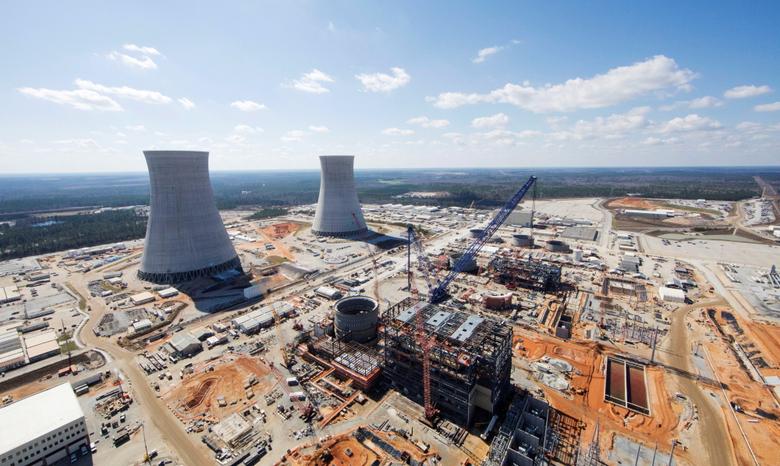
THE LARGEST U.S. NUCLEAR POWER PLANT

Kent Knutson Energy Market Content SpecialistABB Inc
ENERGYCENTRAL - The Southern Company operated Alvin W. Vogtle Electric Generating Plant (Plant Vogtle) is home to two operating 1,180 megawatt (MW) reactors, and two 1,100 MW units currently under construction in the city of Waynesboro, Burke County, Georgia.
The project (4,560 MW), when fully operational at the end of 2022, will not only create the largest power plant in American but the largest generator of carbon-free power in the country as well.
The two-unit construction project is about 84% complete with Vogtle 3 expected online by the end of 2021, and Vogtle 4 by the end of 2022. Construction on the two reactors started back in 2013. The massive construction project is the largest job generator in the state of Georgia, with more than 9,000 employees, and once completed, the plant will be home to 800 permanent jobs.
Southern Company subsidiary, Georgia Power, is the largest owner of Plant Vogtle (45.7%), with generation cooperative Oglethorpe Power (30%), the Municipal Electric Authority of Georgia (MEAG) (22.7%) and Dalton Utilities also holding (1.6%) ownership shares.
The operator of Plant Vogtle is Southern Company subsidiary Southern Nuclear Operations LLC, headquartered in Birmingham, Alabama, coincidentally, the city Alvin W. Vogtle was born. Southern Nuclear operates Southern Company's six nuclear units spread across three locations in the south.
Alvin W. Vogtle's storied life
Plant Vogtle owes its name to Alvin Ward Vogtle Jr., a World War II fighter pilot who was also an esteemed American lawyer, business executive, and from 1969 to 1983, was President and Chairman of the Board of Southern Company. During his service in WW II, Alvin flew over 30 missions before running short of fuel and landing in German-held northern Africa, where he was captured and moved to a prison camp in Germany. During his three years of captivity, Vogtle attempted four unsuccessful escapes, and on the fifth try, in March 1945, he reached safety by scaling a 14-foot barbed-wire border fence and crossed the Rhine making it to freedom in Switzerland. Vogtle was the inspiration for the American prisoner of war (POW) character portrayed by iconic Hollywood actor Steve McQueen in the blockbuster 1963 film, The Great Escape. What a fitting person to have the largest future American power plant named after.
Recent milestones
March was a busy month for milestones at the construction site. On March 5, the company ordered the first nuclear fuel load for Vogtle 4. The company ordered the fuel load for Vogtle 3 last year.
On March 27, the company announced they had placed the containment vessel top-head on Vogtle 4, yet another milestone on the road to completion. According to the company announcement, the structure is 130 feet in diameter, 37 feet tall and weighs about 750 tons.
Southern Nuclear Operations LLC and Georgia Power, both subsidiaries of Southern Company, currently manage project construction. The two new units are the first to deploy Westinghouse AP1000 (Advanced Pressurized Technology), which among many other attributes, enables the reactor-cores to cool without operator interventions. The two new units are the only Generation III+ reactor designs receiving Design Certification from the U.S. Nuclear Regulatory Commission (NRC) and represent the only two large-scale nuclear reactors being built in the U.S in more than 30 years.
Plant Vogtle has been a large consistent power producer
Over the past three decades, the two reactors at Plant Vogtle have generated at an average capacity factor of 92.5% – nearly 20 million MWh per year. As recent as 2017, a new digital turbine control system was installed, helping to ensure continued reliable production of electricity well into the future.
When the two new units are operational, the estimated capacity of the plant will reach 4,560 MW, making it the largest generating plant in the United States. Power output for the full operating plant will likely reach 40 million MWh per year, making Plant Vogtle the largest producer of electricity in the country, exceeding that currently produced at Arizona's mammoth Palo Verde Nuclear Plant (3,968 MW) that has produced at an annual average rate of 31.8 million MWh over the past decade. When construction is complete, and the plant is fully operational, Plant Vogtle will generate nearly twice as much power as the iconic Grand Coulee Dam in Washington produces, and will account for roughly 30% of all power production by all plants in Georgia. The new plant will generate more power than all electricity production in 16 separate states and the District of Columbia, including Connecticut and Nevada. With Plant Vogtle at full operation, Georgia will be producing nearly 40% of the state's electricity from zero-carbon resources.
Power generation in the state of Georgia
Today electricity production from power plants located in Georgia is dominated by natural gas, nuclear, and coal – fuels that account for 91.2% (118.5 million MWh) of total power output. Wind power is yet to take hold as a renewable resource, while hydro (3.0%), solar (1.5%) and biofuels (3.9%) from wood byproducts account for the rest of renewable electricity production. Other non-coal and non-natural gas fossil fuels (0.4%) generate a small portion of the state's power supply.
Like the building of Hoover and Grand Coulee Dams, as well as the construction of numerous large-scale nuclear and steam power plants, stretched across the country, the completion of Plant Vogtle will be considered one of the great American power projects ever constructed. When fully operational at the end of 2022, the plant will be the largest power plant in America and will be the largest generator of carbon-free power in the country.
-----
This thought leadership article was originally shared with Energy Central's Generation Professionals Group. The communities are a place where professionals in the power industry can share, learn and connect in a collaborative environment. Join the Generation Professionals Community today and learn from others who work in the industry.
-----










